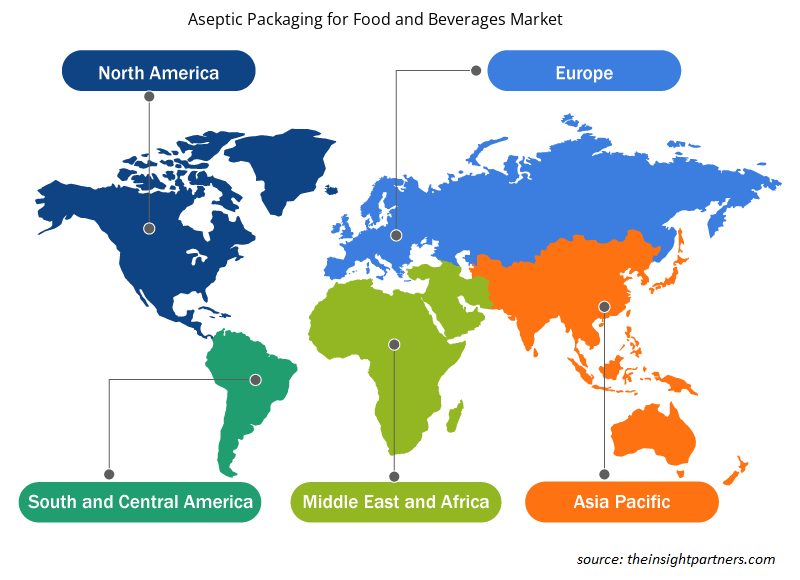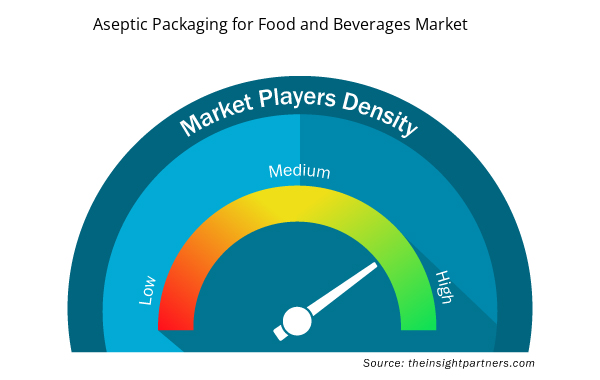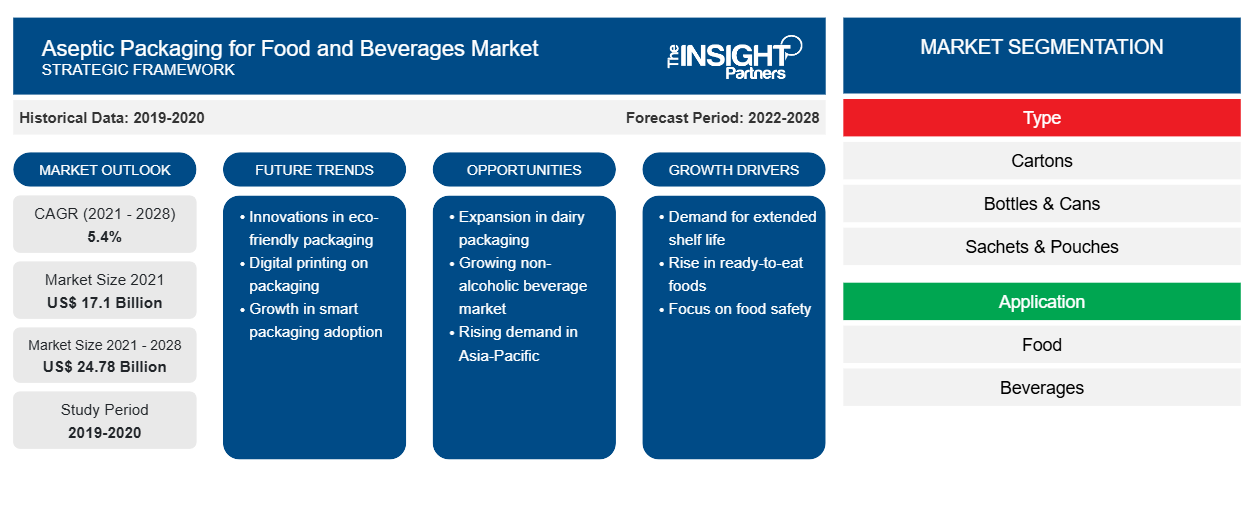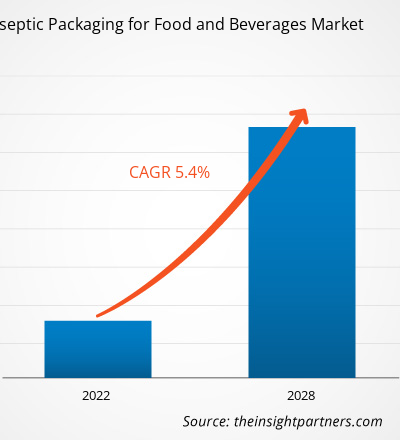Si prevede che il mercato degli imballaggi asettici per alimenti e bevande raggiungerà i 24.782,33 milioni di dollari nel 2028, rispetto ai 17.097,86 milioni di dollari nel 2021; si prevede una crescita a un CAGR del 5,4% dal 2021 al 2028.
Il confezionamento asettico è un processo termico ad alta temperatura e breve durata utilizzato per sterilizzare commercialmente un prodotto e riempire il prodotto raffreddato e sterilizzato in una confezione pre-sterilizzata in un ambiente sterilizzato. Durante il processo, la riempitrice asettica è progettata per sterilizzare il materiale di confezionamento, riempire il prodotto sterile nel contenitore in un ambiente sterilizzato e quindi sigillare ermeticamente la confezione. La riempitrice asettica differisce dai tradizionali sistemi di confezionamento alimentare, in quanto in questo caso il prodotto alimentare e la confezione vengono sterilizzati separatamente. Il confezionamento asettico è utilizzato principalmente nell'industria alimentare e delle bevande. La massiccia crescita dell'industria alimentare e delle bevande a livello globale è dovuta all'aumento della popolazione, al miglioramento degli stili di vita, all'aumento del reddito pro capite e alla crescente domanda di cibi e bevande pronti, che si prevede apriranno opportunità cruciali per il confezionamento asettico per il mercato alimentare e delle bevande nel periodo di previsione.
Il Nord America ha detenuto la quota maggiore del mercato globale degli imballaggi asettici per alimenti e bevande nel 2020, mentre si prevede che l'Asia-Pacifico crescerà in modo significativo nel periodo di previsione. Il concetto di pronto da mangiare o da bere è di tendenza in Nord America. Ultimamente, il mercato delle bevande pronte da bere è cresciuto notevolmente a causa della crescente preferenza per cibi e bevande pronti che aiutano a risparmiare tempo e fatica. L'imballaggio asettico per alimenti e bevande è essenziale per estenderne la durata di conservazione. Pertanto, la crescente tendenza al consumo di bevande pronte da bere sta guidando la crescita del mercato degli imballaggi asettici per alimenti e bevande in Nord America. I venditori offrono imballaggi asettici specializzati per prodotti pronti da bere. Ad esempio, Graham Packaging offre plastica riciclabile per imballaggi asettici per garantire una maggiore durata di conservazione per imballaggi monodose. Pertanto, vari attori di mercato emergenti e affermati nella regione che offrono soluzioni innovative di imballaggio asettico stanno guidando la crescita del mercato.
Personalizza questo report in base alle tue esigenze
Riceverai la personalizzazione gratuita di qualsiasi report, comprese parti di questo report, o analisi a livello nazionale, pacchetto dati Excel, oltre a usufruire di grandi offerte e sconti per start-up e università
- Scopri le principali tendenze di mercato in questo rapporto.Questo campione GRATUITO includerà analisi di dati che spaziano dalle tendenze di mercato alle stime e alle previsioni.
Impatto della pandemia di COVID-19 sul mercato degli imballaggi asettici per alimenti e bevande
Durante la pandemia di COVID-19, il settore chimico e dei materiali ha dovuto affrontare sfide senza precedenti a causa della carenza di materie prime, della chiusura delle fabbriche, della carenza di manodopera e di altre difficoltà operative dovute ai protocolli di sicurezza pandemici. La chiusura delle unità produttive, la difficoltà nell'approvvigionamento di materie prime e le restrizioni alla logistica hanno avuto un impatto negativo sul confezionamento asettico globale per il mercato alimentare e delle bevande. A causa dello scoppio del COVID-19, le preoccupazioni igieniche dei consumatori sono aumentate in modo significativo. Le preferenze dei consumatori si stanno rapidamente evolvendo verso una lunga conservazione e un confezionamento sterile, il che ha avuto un impatto positivo sul confezionamento asettico per il mercato alimentare e delle bevande. Secondo uno studio sull'e-commerce nel Tetra Pak Index 2021, i consumatori hanno sempre più valutato i cartoni asettici come il materiale di imballaggio ideale per gli acquisti online. Pertanto, la crescente preoccupazione per la sicurezza e l'igiene alimentare dovuta allo scoppio del COVID-19 sta alimentando la crescita del confezionamento asettico per il mercato alimentare e delle bevande. Pertanto, la pandemia di COVID-19 ha avuto un impatto misto sul mercato del confezionamento asettico per il mercato alimentare e delle bevande.
Market Insights
I vantaggi associati al confezionamento asettico stanno guidando la crescita del mercato
Ci sono vari vantaggi associati al confezionamento asettico per prodotti alimentari e bevande. Il confezionamento asettico aiuta ad aumentare la durata di conservazione dei prodotti alimentari e bevande di circa sei-dodici mesi senza refrigerazione. La maggiore longevità del prodotto offre ai produttori più tempo per spedire e vendere i loro prodotti prima che scadano o perdano sapore. Ciò ha anche ridotto i costi di trasporto e logistica. Il confezionamento asettico è leggero e compatto rispetto ai tipi di imballaggio più tradizionali, consentendo ai produttori di tagliare i costi di spedizione riducendo il peso della spedizione. C'è stata una crescente domanda di prodotti alimentari pronti con lunga durata di conservazione, che sono privi di contaminazione batterica o possono ritardarla. I conservanti alimentari sono ampiamente utilizzati nella produzione alimentare per aumentare la durata di conservazione e preservare la qualità del prodotto. Tuttavia, i consumatori preferiscono prodotti più naturali privi di additivi sintetici. Il confezionamento asettico integra anche gli ingredienti naturali, consentendo a un produttore di produrre un prodotto completamente naturale e renderlo sempre più stabile a scaffale. Pertanto, vari vantaggi del confezionamento asettico stanno guidando la crescita del mercato del confezionamento asettico per alimenti e bevande.
Tipo Informazioni
In base al tipo, il mercato degli imballaggi asettici per alimenti e bevande è segmentato in cartoni, bottiglie e lattine, bustine e sacchetti e altri. Si prevede che il segmento delle bustine e dei sacchetti crescerà al CAGR più rapido nel mercato globale degli imballaggi asettici per alimenti e bevande nel periodo di previsione. L'imballaggio a sacchetto asettico include una soluzione innovativa di beccuccio e tappo per consentire una soluzione di imballaggio sicura e comoda. Questa bustina è sviluppata per offrire ai consumatori praticità e facilità d'uso. Può avere una durata di conservazione fino a 12 mesi, offrendo al contempo una ritenzione ottimale dei nutrienti, sapori e consistenze. Le bustine sono piccole buste flessibili sigillate che includono imballaggi a tre o quattro strati realizzati con una pellicola arrotolata o piatta. La crescente domanda di prodotti alimentari e bevande in quantità più ridotte sta guidando la crescita del segmento delle bustine e dei sacchetti asettici.
Imballaggi asettici per il mercato alimentare e delle bevande - Approfondimenti regionali
Le tendenze regionali e i fattori che influenzano il mercato degli imballaggi asettici per alimenti e bevande durante il periodo di previsione sono stati ampiamente spiegati dagli analisti di Insight Partners. Questa sezione discute anche i segmenti e la geografia del mercato degli imballaggi asettici per alimenti e bevande in Nord America, Europa, Asia Pacifico, Medio Oriente e Africa e America meridionale e centrale.

- Ottieni i dati specifici regionali per il mercato degli imballaggi asettici per alimenti e bevande
Ambito del rapporto di mercato sugli imballaggi asettici per alimenti e bevande
| Attributo del report | Dettagli |
|---|---|
| Dimensioni del mercato nel 2021 | 17,1 miliardi di dollari USA |
| Dimensioni del mercato entro il 2028 | 24,78 miliardi di dollari USA |
| CAGR globale (2021 - 2028) | 5,4% |
| Dati storici | 2019-2020 |
| Periodo di previsione | 2022-2028 |
| Segmenti coperti | Per tipo
|
| Regioni e Paesi coperti | America del Nord
|
| Leader di mercato e profili aziendali chiave |
|
Confezionamento asettico per alimenti e bevande Attori del mercato Densità: comprendere il suo impatto sulle dinamiche aziendali
Il mercato del confezionamento asettico per alimenti e bevande sta crescendo rapidamente, spinto dalla crescente domanda degli utenti finali dovuta a fattori quali l'evoluzione delle preferenze dei consumatori, i progressi tecnologici e una maggiore consapevolezza dei benefici del prodotto. Con l'aumento della domanda, le aziende stanno ampliando le loro offerte, innovando per soddisfare le esigenze dei consumatori e capitalizzando sulle tendenze emergenti, il che alimenta ulteriormente la crescita del mercato.
La densità degli operatori di mercato si riferisce alla distribuzione di aziende o società che operano in un particolare mercato o settore. Indica quanti concorrenti (operatori di mercato) sono presenti in un dato spazio di mercato in relazione alle sue dimensioni o al valore di mercato totale.
Le principali aziende che operano nel mercato degli imballaggi asettici per alimenti e bevande sono:
- Tetra Pak ItaliaPak International S.A
- Aria sigillata
- Azienda di imballaggio asettico Greatview Aseptic Packaging Company
- GRUPPO SIDEL GROUP
- ECOLEAN AB AB
Disclaimer : le aziende elencate sopra non sono classificate secondo un ordine particolare.

- Ottieni la panoramica dei principali attori del mercato degli imballaggi asettici per alimenti e bevande
Approfondimenti sulle applicazioni
In base all'applicazione, il mercato degli imballaggi asettici per alimenti e bevande è segmentato in alimenti e bevande. Il segmento alimentare è ulteriormente suddiviso in latticini; frutta e verdura; carne, pollame e frutti di mare; alimenti trasformati; e altri. Il segmento delle bevande è ulteriormente suddiviso in latticini, succhi, bevande pronte da bere e altri. Il segmento delle bevande ha detenuto una quota maggiore nel mercato globale nel 2020. Gli imballaggi asettici sono utilizzati per varie bevande, tra cui a base di frutta, latticini, latte, frullati proteici, tè pronto da bere (RTD) e caffè freddo, acque aromatizzate e cocktail. La crescente domanda da parte dei consumatori di bevande senza sostanze chimiche e conservanti sta guidando la crescita degli imballaggi asettici per il mercato degli alimenti e delle bevande.
I principali attori che operano nel mercato del confezionamento asettico per alimenti e bevande includono Tetra Pak International SA, Sealed Air, Greatview Aseptic Packaging Company, Sidel Group, ECOLEAN AB, Krones AG, Syntegon Technology GmbH (Bosch Packaging Technology), Amcor Group GmbH, IPI Srl e SIG Combibloc Group AG. Questi attori sono impegnati nello sviluppo di prodotti innovativi per soddisfare le tendenze emergenti dei consumatori. Inoltre, sono coinvolti in fusioni e acquisizioni, espansione aziendale e partnership per espandere la loro quota di mercato a livello globale.Pak International SA, Sealed Air, Greatview Aseptic Packaging Company, Sidel Group, ECOLEAN AB, Krones AG, Syntegon Technology GmbH (Bosch Packaging Technology), Amcor Group GmbH, IPI S.r.l., and SIG Combibloc Group AG. These players are engaged in developing innovative products to meet the emerging consumer trends. Moreover, they are involved in mergers & acquisitions, business expansion, and partnerships to expand their market share globally.
Segnala i riflettori
- Tendenze industriali progressive nel mercato degli imballaggi asettici per alimenti e bevande per aiutare gli operatori a sviluppare strategie efficaci a lungo termine
- Strategie di crescita aziendale adottate dai mercati sviluppati e in via di sviluppo
- Analisi quantitativa del mercato degli imballaggi asettici per alimenti e bevande dal 2019 al 2028
- Stima della domanda globale di imballaggi asettici per alimenti e bevande
- Analisi delle cinque forze di Porter per illustrare l'efficacia degli acquirenti e dei fornitori che operano nel settore
- Sviluppi recenti per comprendere lo scenario competitivo del mercato
- Tendenze e prospettive di mercato, nonché fattori che guidano e frenano la crescita del mercato degli imballaggi asettici per alimenti e bevande
- Assistenza nel processo decisionale evidenziando le strategie di mercato che sostengono l'interesse commerciale, portando alla crescita del mercato
- La dimensione del mercato degli imballaggi asettici per alimenti e bevande in vari nodi
- Panoramica dettagliata e segmentazione del mercato, nonché dinamiche del settore dell'imballaggio asettico per alimenti e bevande
- Dimensioni del mercato degli imballaggi asettici per alimenti e bevande in diverse regioni con promettenti opportunità di crescita
- Analisi storica (2 anni), anno base, previsione (7 anni) con CAGR
- Analisi PEST e SWOT
- Valore/volume delle dimensioni del mercato - Globale, regionale, nazionale
- Industria e panorama competitivo
- Set di dati Excel


- Retinal Imaging Devices Market
- Aircraft Landing Gear Market
- Legal Case Management Software Market
- Hand Sanitizer Market
- Tortilla Market
- MEMS Foundry Market
- Explosion-Proof Equipment Market
- Pressure Vessel Composite Materials Market
- Artwork Management Software Market
- Biopharmaceutical Contract Manufacturing Market

Report Coverage
Revenue forecast, Company Analysis, Industry landscape, Growth factors, and Trends

Segment Covered
This text is related
to segments covered.

Regional Scope
North America, Europe, Asia Pacific, Middle East & Africa, South & Central America

Country Scope
This text is related
to country scope.
Domande frequenti
Adoption of sustainable and environmental-friendly packaging is the key trend for the global aseptic packaging for food and beverage market. The increased use of plastic packaging in the food and beverage industry has harmful impacts on the environment. This has led to an increased focus on developing sustainable and environmental-friendly packaging.
Based on food & beverage, the food segment led the global aseptic packaging for food and beverage market in 2020. In the food segment fruits & vegetable, product is increasing as it is perishable in nature and aseptic packaging helps to increase longer shelf life. Thus this increase demand for aseptic packaging for food and beverage.
Based on the type segment, sachets & pouches was the fastest-growing segment in 2020. The aseptic sachets & pouch packaging is pre-made, sterilized spouted sachets & pouch packaging which is used to preserve the quality of the product. Aseptic sachets & pouch are shelf-stable and require no refrigeration.
In 2020, Asia Pacific accounted for the largest share of the global aseptic packaging for food and beverage market. The aseptic packaging for food and beverage market industry is anticipated to expand faster due to its benefits like longer shelf life of food and beverage.
Surging demand for dairy products and benefits associated with aseptic packaging are the drivers for global aseptic packaging for food and beverage market. The growing demand for dairy products has led to an increased focus on developing safe and hygienic packaging for dairy products. Aseptic packaging is increasingly used as a packaging solution for ultra-high temperature (UHT) milk. Aseptic packaging helps increase the shelf life of the food and beverage products.
The major players operating in the global aseptic packaging for food and beverage market are Tetra Pak International S.A.; Sealed Air Corporation; Greatview Aseptic Packaging Co., Ltd.; Sidel International; Ecolean AB; Krones AG; Syntegon Technology GmbH; IPI S.r.l.; SIG Combibloc Group AG; Amcor plc.
Trends and growth analysis reports related to Chemicals and Materials : READ MORE..
The List of Companies - Aseptic Packaging for Food and Beverage Market
- Tetra Pak International S.A
- Sealed Air
- Greatview Aseptic Packaging Company
- SIDEL GROUP
- ECOLEAN AB
- Krones AG
- Syntegon Technology GmbH (Bosch Packaging Technology)
- SIG Combibloc Group AG
- IPI S.R.L.
- Amcor plc
The Insight Partners performs research in 4 major stages: Data Collection & Secondary Research, Primary Research, Data Analysis and Data Triangulation & Final Review.
- Data Collection and Secondary Research:
As a market research and consulting firm operating from a decade, we have published and advised several client across the globe. First step for any study will start with an assessment of currently available data and insights from existing reports. Further, historical and current market information is collected from Investor Presentations, Annual Reports, SEC Filings, etc., and other information related to company’s performance and market positioning are gathered from Paid Databases (Factiva, Hoovers, and Reuters) and various other publications available in public domain.
Several associations trade associates, technical forums, institutes, societies and organization are accessed to gain technical as well as market related insights through their publications such as research papers, blogs and press releases related to the studies are referred to get cues about the market. Further, white papers, journals, magazines, and other news articles published in last 3 years are scrutinized and analyzed to understand the current market trends.
- Primary Research:
The primarily interview analysis comprise of data obtained from industry participants interview and answers to survey questions gathered by in-house primary team.
For primary research, interviews are conducted with industry experts/CEOs/Marketing Managers/VPs/Subject Matter Experts from both demand and supply side to get a 360-degree view of the market. The primary team conducts several interviews based on the complexity of the markets to understand the various market trends and dynamics which makes research more credible and precise.
A typical research interview fulfils the following functions:
- Provides first-hand information on the market size, market trends, growth trends, competitive landscape, and outlook
- Validates and strengthens in-house secondary research findings
- Develops the analysis team’s expertise and market understanding
Primary research involves email interactions and telephone interviews for each market, category, segment, and sub-segment across geographies. The participants who typically take part in such a process include, but are not limited to:
- Industry participants: VPs, business development managers, market intelligence managers and national sales managers
- Outside experts: Valuation experts, research analysts and key opinion leaders specializing in the electronics and semiconductor industry.
Below is the breakup of our primary respondents by company, designation, and region:

Once we receive the confirmation from primary research sources or primary respondents, we finalize the base year market estimation and forecast the data as per the macroeconomic and microeconomic factors assessed during data collection.
- Data Analysis:
Once data is validated through both secondary as well as primary respondents, we finalize the market estimations by hypothesis formulation and factor analysis at regional and country level.
- Macro-Economic Factor Analysis:
We analyse macroeconomic indicators such the gross domestic product (GDP), increase in the demand for goods and services across industries, technological advancement, regional economic growth, governmental policies, the influence of COVID-19, PEST analysis, and other aspects. This analysis aids in setting benchmarks for various nations/regions and approximating market splits. Additionally, the general trend of the aforementioned components aid in determining the market's development possibilities.
- Country Level Data:
Various factors that are especially aligned to the country are taken into account to determine the market size for a certain area and country, including the presence of vendors, such as headquarters and offices, the country's GDP, demand patterns, and industry growth. To comprehend the market dynamics for the nation, a number of growth variables, inhibitors, application areas, and current market trends are researched. The aforementioned elements aid in determining the country's overall market's growth potential.
- Company Profile:
The “Table of Contents” is formulated by listing and analyzing more than 25 - 30 companies operating in the market ecosystem across geographies. However, we profile only 10 companies as a standard practice in our syndicate reports. These 10 companies comprise leading, emerging, and regional players. Nonetheless, our analysis is not restricted to the 10 listed companies, we also analyze other companies present in the market to develop a holistic view and understand the prevailing trends. The “Company Profiles” section in the report covers key facts, business description, products & services, financial information, SWOT analysis, and key developments. The financial information presented is extracted from the annual reports and official documents of the publicly listed companies. Upon collecting the information for the sections of respective companies, we verify them via various primary sources and then compile the data in respective company profiles. The company level information helps us in deriving the base number as well as in forecasting the market size.
- Developing Base Number:
Aggregation of sales statistics (2020-2022) and macro-economic factor, and other secondary and primary research insights are utilized to arrive at base number and related market shares for 2022. The data gaps are identified in this step and relevant market data is analyzed, collected from paid primary interviews or databases. On finalizing the base year market size, forecasts are developed on the basis of macro-economic, industry and market growth factors and company level analysis.
- Data Triangulation and Final Review:
The market findings and base year market size calculations are validated from supply as well as demand side. Demand side validations are based on macro-economic factor analysis and benchmarks for respective regions and countries. In case of supply side validations, revenues of major companies are estimated (in case not available) based on industry benchmark, approximate number of employees, product portfolio, and primary interviews revenues are gathered. Further revenue from target product/service segment is assessed to avoid overshooting of market statistics. In case of heavy deviations between supply and demand side values, all thes steps are repeated to achieve synchronization.
We follow an iterative model, wherein we share our research findings with Subject Matter Experts (SME’s) and Key Opinion Leaders (KOLs) until consensus view of the market is not formulated – this model negates any drastic deviation in the opinions of experts. Only validated and universally acceptable research findings are quoted in our reports.
We have important check points that we use to validate our research findings – which we call – data triangulation, where we validate the information, we generate from secondary sources with primary interviews and then we re-validate with our internal data bases and Subject matter experts. This comprehensive model enables us to deliver high quality, reliable data in shortest possible time.


 Ottieni un campione gratuito per questo repot
Ottieni un campione gratuito per questo repot